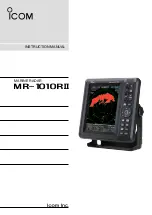
Micropilot FMR66B HART
Hauser
V. 1, Rev. 2, 26-07-2022
19
Drip-off, PTFE 50 mm (2 in) antenna, α = 6 °
W = D × 0.10
D
W
D
W
α
5 m (16 ft)
0.52 m (1.70 ft)
10 m (33 ft)
1.04 m (3.41 ft)
15 m (49 ft)
1.56 m (5.12 ft)
20 m (66 ft)
2.08 m (6.82 ft)
25 m (82 ft)
2.60 m (8.53 ft)
30 m (98 ft)
3.12 m (10.24 ft)
35 m (115 ft)
3.64 m (11.94 ft)
40 m (131 ft)
4.16 m (13.65 ft)
45 m (148 ft)
4.68 m (15.35 ft)
50 m (164 ft)
5.20 m (17.06 ft)
Special mounting
instructions
External measurement through plastic cover or dielectric windows
• Dielectric constant of medium: ε
r
≥ 10
• The distance from the tip of the antenna to the tank should be approx. 100 mm (4 in).
• Avoid installation positions where condensate or buildup can form between the antenna and the
vessel
• In the case of outdoor installations, ensure that the area between the antenna and the tank is
protected from the weather
• Do not install any fittings or attachments between the antenna and the tank that could reflect the
signal
The thickness of the tank ceiling or the dielectric window depends on the ε
r
of the material.
The material thickness can be a full multiple of the optimum thickness (table); it is important to
note, however, that the microwave transparency decreases significantly with increasing material
thickness.
Optimum material thickness
Material
Optimum material thickness
PE; ε
r
2.3
1.25 mm (0.049 in)
PTFE; ε
r
2.1
1.30 mm (0.051 in)
PP; ε
r
2.3
1.25 mm (0.049 in)
Perspex; ε
r
3.1
1.10 mm (0.043 in)
Container with heat insulation
1
2
A0046566
If process temperatures are high, the device should be included in the usual container insulation
system (2) to prevent the electronics from heating as a result of thermal radiation or convection. The
rib structure (1) must not be insulated.
















































